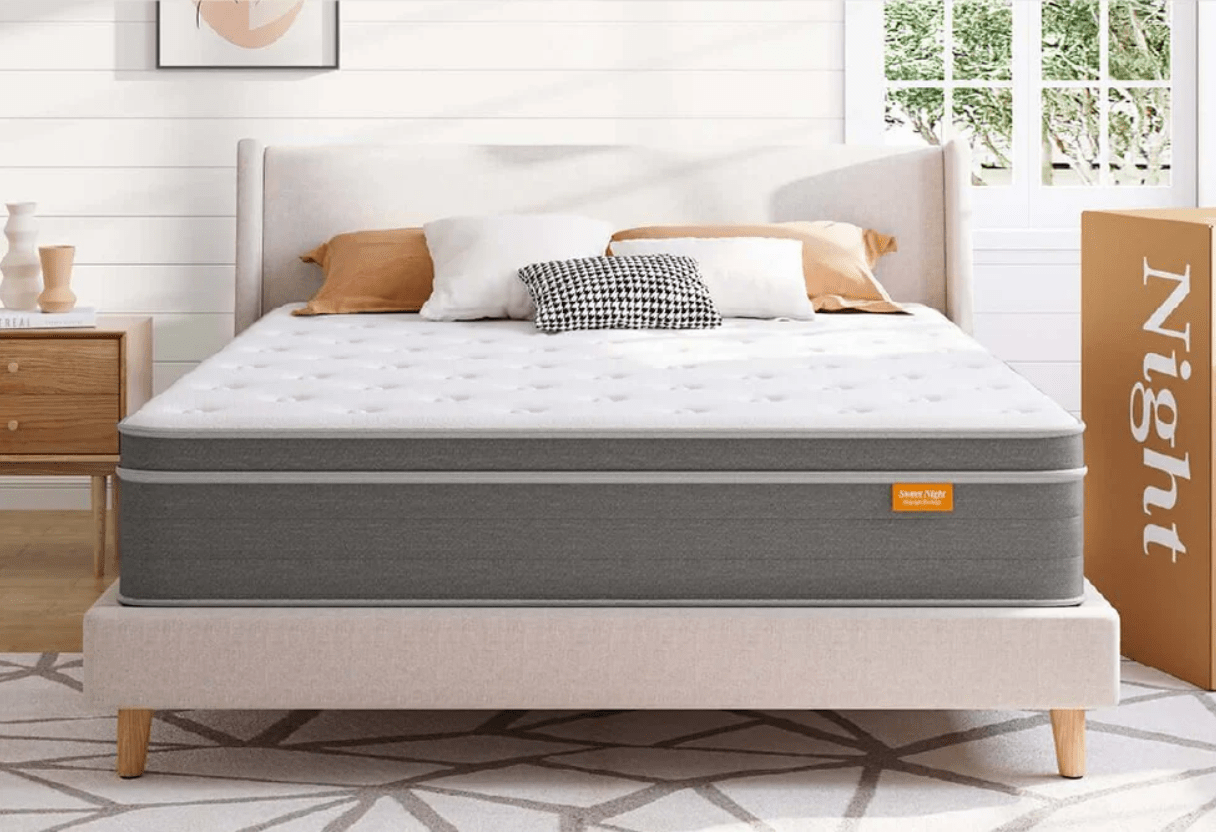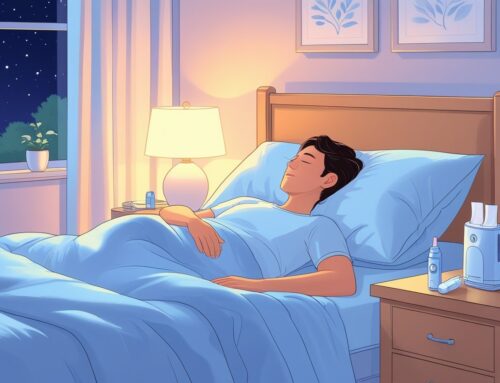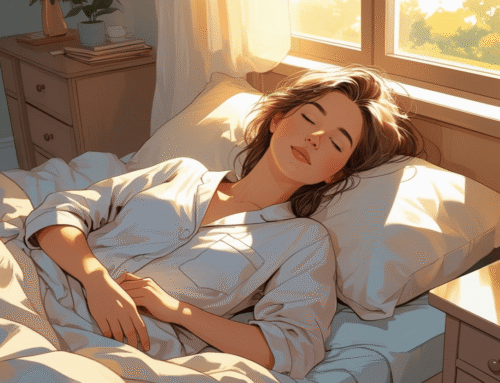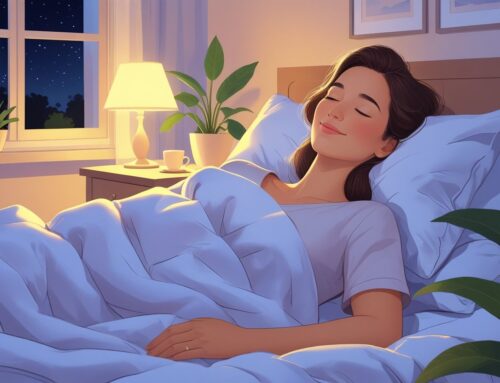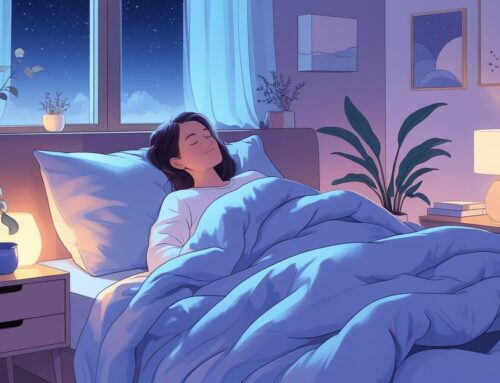For men dealing with an enlarged prostate, the way you sleep can affect how many times you wake up at night to use the bathroom. Sleeping on your side, especially the left side, reduces pressure on the bladder and prostate. This position can ease symptoms and help you sleep for longer stretches. Sleeping on your back with your upper body slightly raised also helps. Gravity keeps fluids from building up in the lower body and lowers nighttime trips to the bathroom.
Sleeping flat on your back or on your stomach can increase pressure and discomfort. Simple changes, like switching to your side, using supportive pillows, or trying a medium-firm mattress, can improve rest. These adjustments won’t fix everything, but they can reduce interruptions and help you wake up feeling less tired.
Daily habits matter too. Combining better sleep positions with healthy routines gives you more control over your bladder. These changes support deeper sleep and fewer trips out of bed. Small improvements in posture and habits together can help you rest more fully.
Key Takeaways
- Side sleeping lowers pressure on the bladder and prostate.
- Sleeping with your upper body slightly raised limits fluid buildup.
- Building good sleep habits reduces how many times you wake at night.
- A medium-firm mattress with side or elevated back sleeping supports comfort and symptom relief.
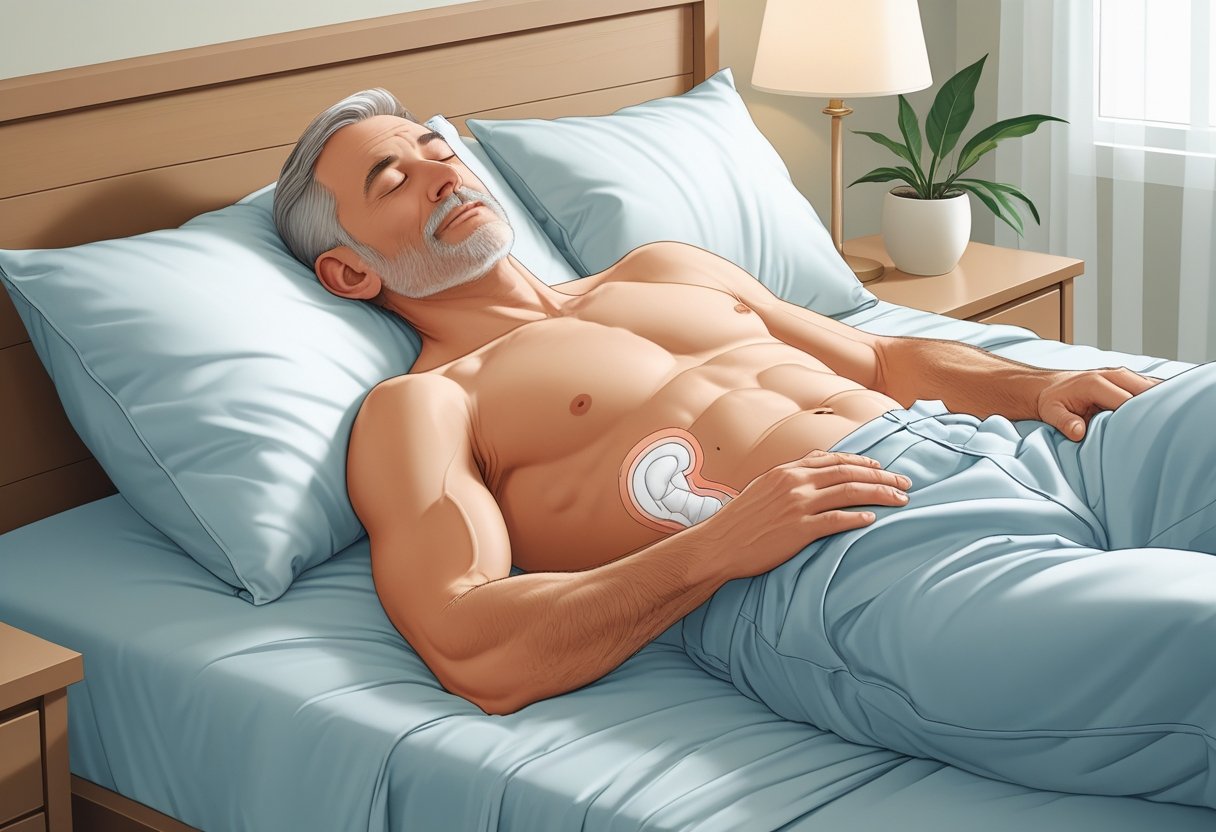
Understanding Enlarged Prostate and Sleep Disruption
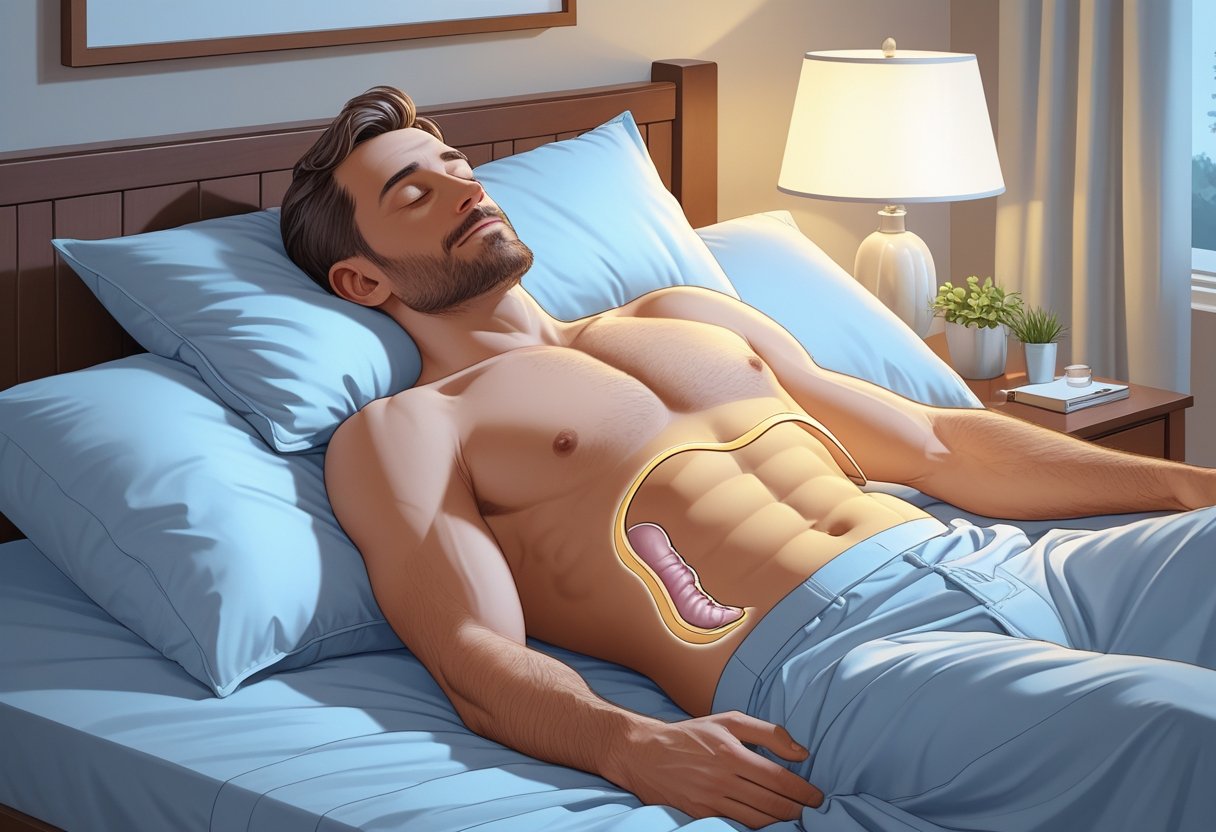
An enlarged prostate can lead to sleep troubles. The main problems are waking up multiple times at night to urinate and feeling discomfort in the pelvic area. These interruptions lower sleep quality and can affect energy and focus during the day.
What Is Benign Prostatic Hyperplasia (BPH)
Benign Prostatic Hyperplasia (BPH) happens when the prostate gland grows larger. It is common in men over 50. The prostate surrounds the urethra, so when it enlarges, it puts pressure on it and slows urine flow. This extra pressure forces the bladder to work harder to empty. Over time, the bladder can get irritated or lose strength. BPH is not cancer and usually grows slowly, but its symptoms can frustrate men and disturb sleep.
Common Nighttime Symptoms of BPH
Men with BPH wake up several times at night to urinate, a problem called nocturia. The enlarged prostate blocks urine flow, so the bladder does not empty completely. Lying down moves fluid from the legs to the kidneys, which increases urine at night. This is why urination can feel more urgent when resting. Other signs include a weak stream, slow urination, hesitation, and sudden urgency. These interruptions make it hard to sleep through the night.
How Poor Sleep Affects Health
Interrupted sleep reduces both the amount and quality of rest. It can cause fatigue during the day, poor focus, and mood changes. Over time, it can raise the risk of heart problems, diabetes, and lower immunity. Nocturia can also bring stress and worry about sleep, which can worsen insomnia. Managing these symptoms is important for prostate health and overall daily well-being.
How Sleeping Position Affects Prostate Symptoms
Sleeping position has a direct influence on the pressure put upon the prostate and bladder, which impacts urinary symptoms. Successful positioning can relieve discomfort, decrease nighttime trips to the bathroom, and enhance sleep quality.
Body Position and Pelvic Pressure
The prostate sits around the urethra, so pressure on the pelvis can change how urine flows. Lying flat on your back can press the prostate against the bladder and urethra, which can make symptoms like urgency or frequent bathroom trips worse.
Sleeping on your side reduces pelvic pressure. Placing a pillow between the knees helps keep the spine straight and prevents twisting. Lying on the left side may help more because it eases bladder pressure and supports digestion. Lying on your stomach puts pressure on the abdomen and can increase prostate discomfort. If you like sleeping this way, a thin pillow under the hips can relieve some pressure.
Bladder Dynamics When Sleeping
When you lie down, fluid from the legs moves back into the abdomen. This can raise urine production at night and cause more trips to the bathroom. Raising the upper body while on your back can limit this fluid buildup. Using a wedge pillow or an adjustable bed to stay slightly reclined can reduce bladder pressure and nighttime urination. Side sleeping also helps by keeping pressure off the bladder. This position supports smoother urine flow and can cut down on waking up several times to pee.
Signs of Aggravated Nocturia
Waking up multiple times at night to urinate shows sleep position could be part of the problem. These interruptions lead to tiredness and lower-quality sleep. Other signs include trouble starting urination or having a weak stream, which may point to extra pressure on the prostate.
Sleeping on the back or stomach can make these symptoms worse. Switching to side sleeping or raising the upper body usually helps with nocturia. If symptoms continue, it’s important to see a doctor to rule out more serious issues.
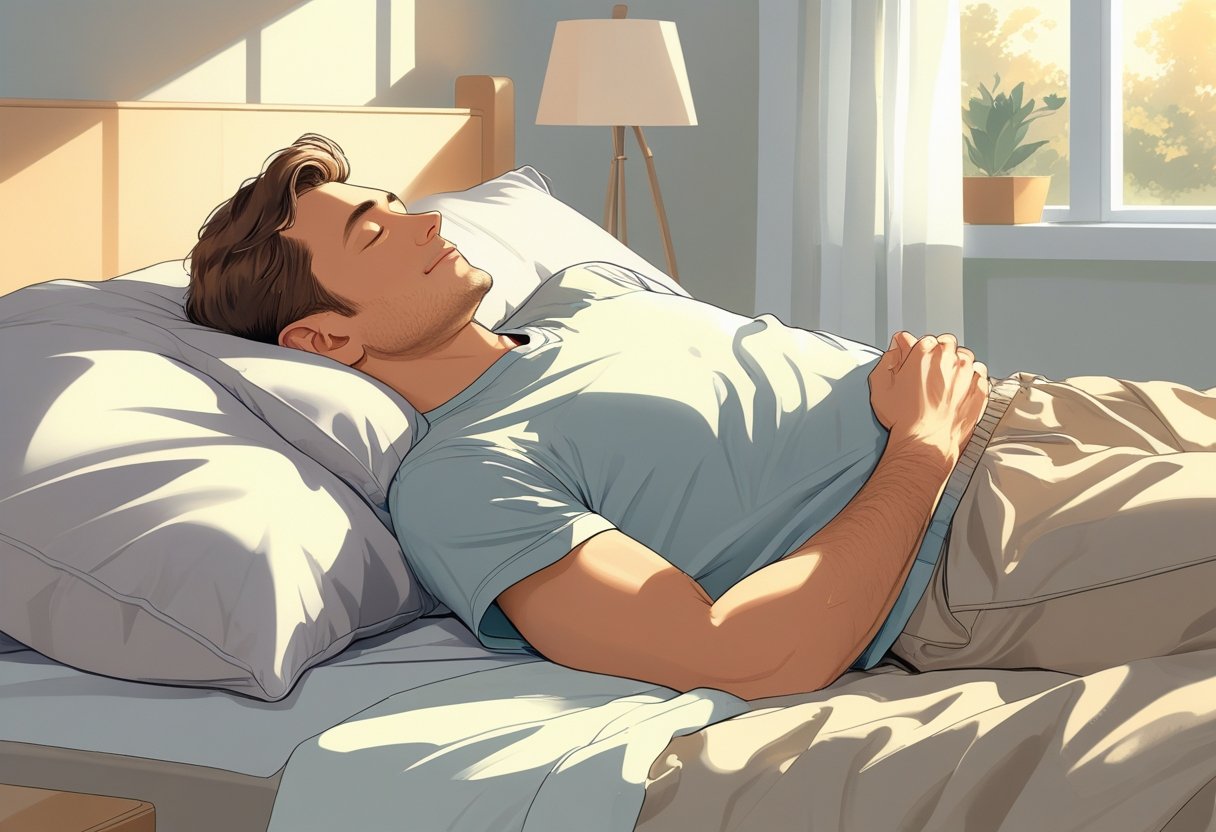
Best Position to Sleep With Enlarged Prostate
It can ease pressure on the prostate and help with symptoms like waking up at night to use the bathroom. Small adjustments, like sleeping on your side and changing how your legs rest, can bring more comfort and help control your bladder better. These changes are simple but can affect how restful your sleep is.
Side Sleeping for Prostate Relief
Lying on your side reduces pressure on the prostate because your weight shifts away from the bladder. This can cut down on night-time trips to the bathroom caused by an enlarged prostate pressing on the urethra. Putting a pillow between your knees helps too. It keeps the spine straight, eases strain on your hips and back, and helps you stay comfortable through the night. With less discomfort, sleep stays more consistent.
Side sleeping can also help with breathing and digestion. It may prevent fluid from settling in your lower body, which can trigger more nighttime urination.
Left vs. Right Side Comparison
Sleeping on the left side can offer extra benefits. It improves blood flow, lowers bladder pressure, and reduces the chance of the prostate pressing on the urethra. This can mean fewer urinary interruptions. The right side can still be comfortable but may not ease bladder pressure as much. Some men prefer this side because it feels natural or due to other health reasons, even if they wake up more.
Trying both sides helps you see what works best. Pillows along your back or hips can stop you from rolling into positions that add pressure during sleep.
Supportive Leg and Hip Positioning
A pillow between your legs does more than make you comfortable. It keeps the spine aligned and reduces pressure on hips and lower back, which can help if prostate issues cause pelvic tension. Raising your legs slightly with a wedge or pillows can improve blood flow and prevent fluid from building in the lower body. Less fluid moving up means the bladder has less to handle at night.
Adjusting the angle of your hips, like supporting your thighs, can reduce pelvic strain. These small changes support bladder comfort and help men with an enlarged prostate get a better night’s rest.
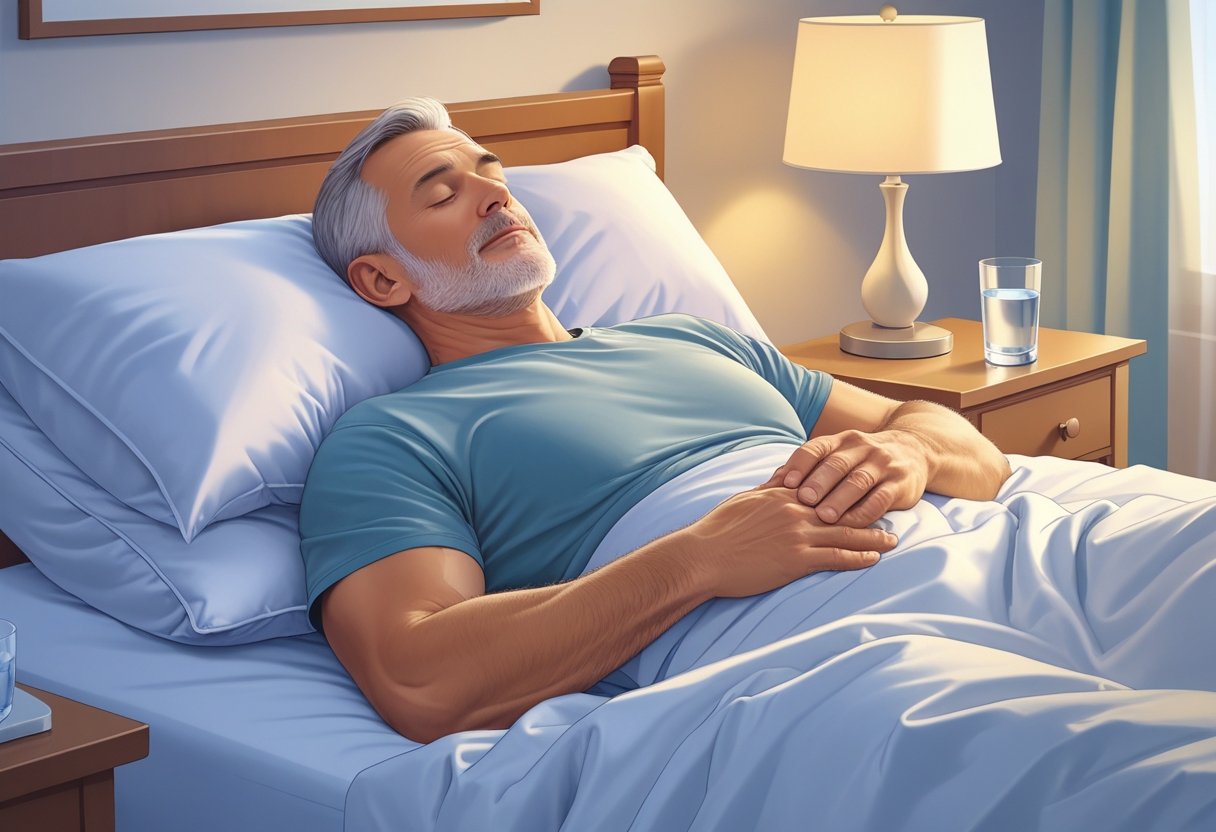
Back and Other Positions: Modifications and Recommendations
Sleeping on your back can be helpful for men with an enlarged prostate, especially when the body is supported the right way. Good alignment eases pressure on the prostate and bladder. With proper pillow placement, it can reduce discomfort and limit trips to the bathroom at night.
Elevating the Upper Body
Raising the upper body while lying on the back lowers pressure on the bladder and prostate. Using a wedge pillow or an adjustable bed to lift the head and torso by 30 to 45 degrees works well. Gravity helps keep fluid from settling in the lower body, which may reduce nighttime urination.
If an adjustable bed isn’t available, firm pillows behind the upper back can create a reclined position. Even a small lift can make breathing easier and improve comfort. Just make sure the neck is supported to avoid strain.
Knee Support Strategies
Placing support under the knees helps the spine stay in a natural curve. A rolled towel or a firm pillow under the knees bends the legs slightly. This eases pressure on the lower back and keeps the body more comfortable. Raising the knees also reduces strain on the bladder area. For men with prostate symptoms, this may lower pelvic tension and help sleep longer without waking up.
Pillow Placement Techniques
Using pillows in the right spots can improve sleep quality. A head pillow is needed, but a body pillow along the torso keeps the body from rolling onto the side or stomach. This keeps the position steady and supported.
For men who switch between side and back sleeping, surrounding the body with pillows adds stability. A small pillow under the hips can reduce pressure on the lower abdomen, which may help with discomfort from an enlarged prostate.
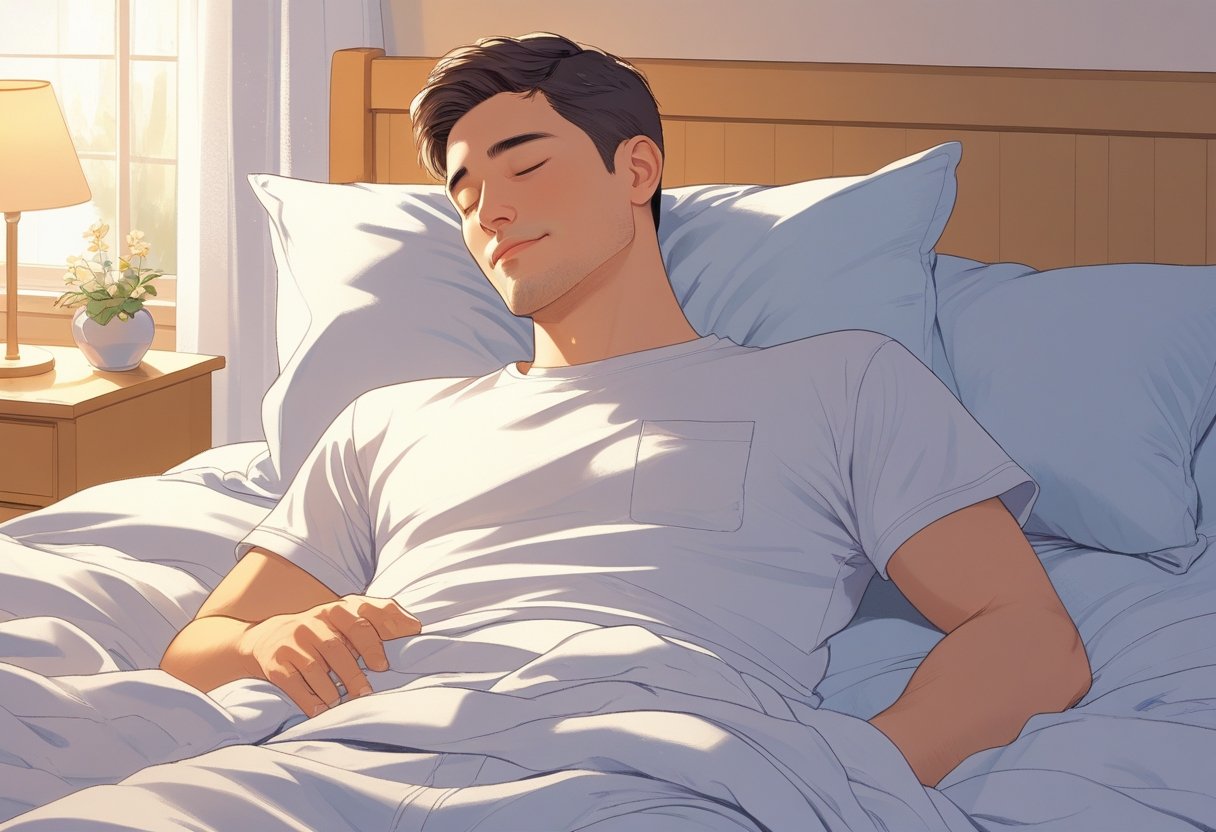
Sleep Positions and Habits to Avoid
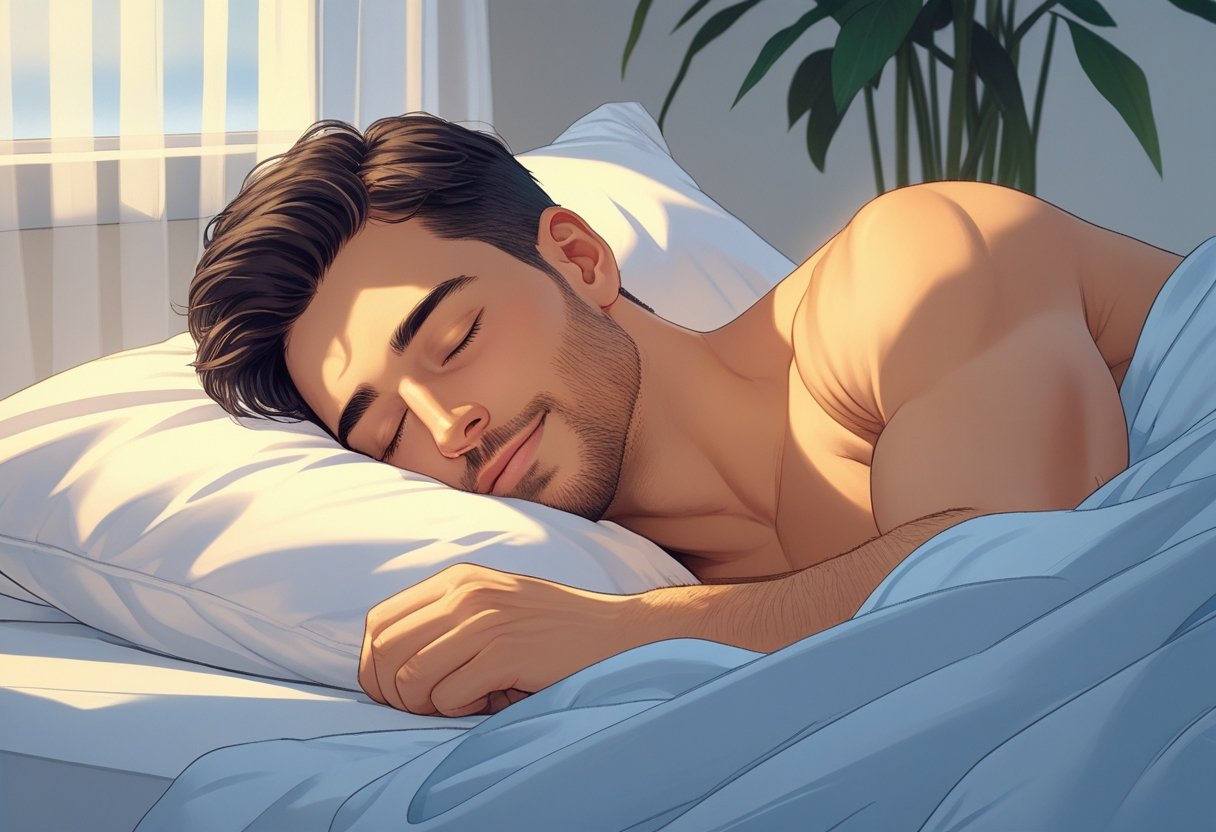
The way you sleep at night can affect how bad prostate symptoms feel. Certain positions put more strain on the bladder and prostate, and some nighttime routines can cause the body to produce more urine. Both of these things lead to poor rest and more bathroom trips.
Dangers of Stomach Sleeping
Sleeping on your stomach puts extra pressure on the bladder and prostate. This can cause discomfort and make you need to urinate more at night. It also affects the spine. Without proper support, back or neck pain can keep you from getting deeper sleep. If you sleep face down, a thin pillow under your hips can reduce pressure on your lower abdomen. Still, this is usually the least comfortable position for men with an enlarged prostate.
Problematic Pre-Bedtime Practices
Drinking a lot of liquid right before bed increases urine output and leads to more trips to the bathroom. Lying down moves fluid in the body, making the kidneys work harder and produce more urine. Caffeine and alcohol can irritate the bladder at night and both can increase the urge to urinate and disturb sleep.
It’s best to avoid large amounts of liquid within two hours of bed and cut off caffeine or alcohol a few hours before sleep to reduce irritation.
Position Changes for Comfort
Changing positions during the night can lower pressure on the bladder and prostate. Side sleeping or reclining slightly usually feels better. Pillows can help maintain a comfortable position through the night. You can also try small adjustments, like propping up your upper body, to reduce nighttime urges without adding discomfort. These changes can help manage symptoms and improve sleep.
Optimizing the Sleep Environment for Prostate Health
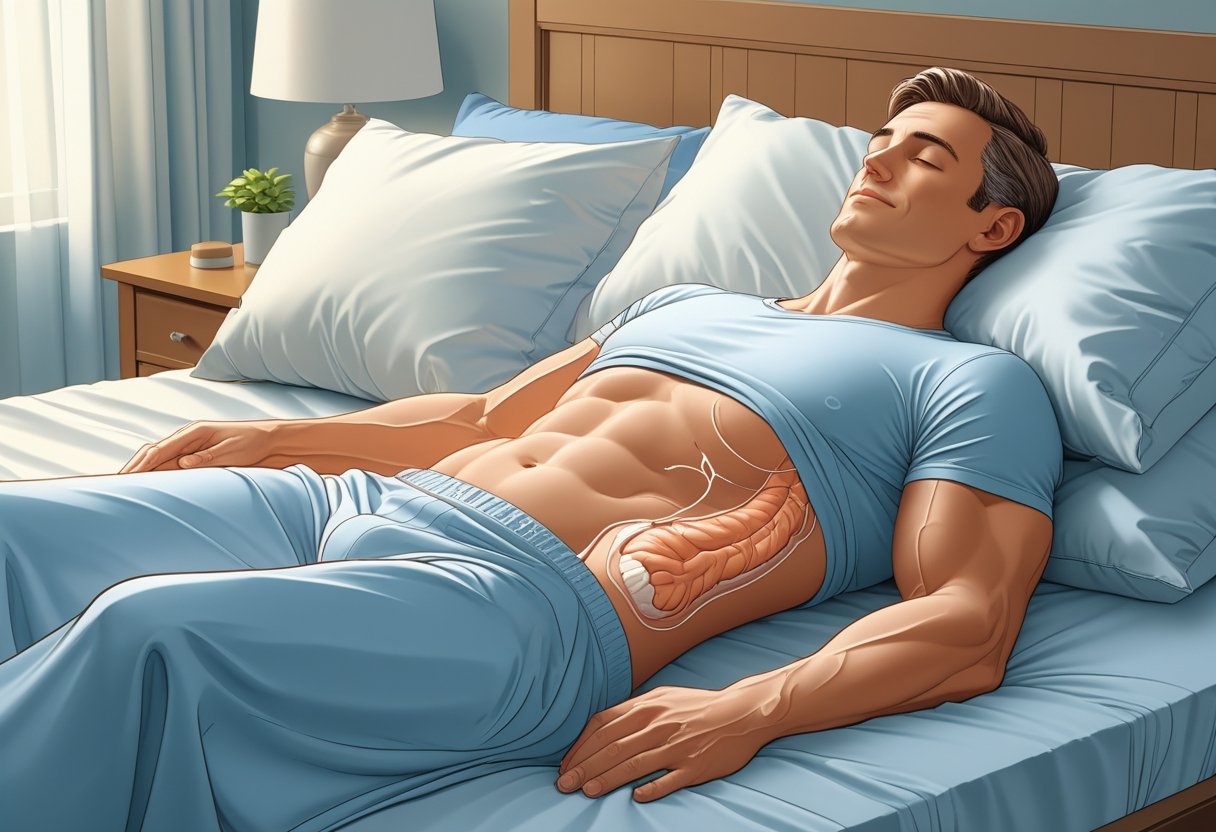
An effective sleep arrangement may alleviate discomfort due to an enlarged prostate and limit excessive use of the bathroom
Getting good sleep can be hard when an enlarged prostate causes frequent trips to the bathroom. The right bedroom setup can help. Choosing the right mattress, pillows, and accessories, and even simple things like comfortable pajamas, can reduce pressure and help you rest more soundly.
Selecting the Right Mattress and Bedding
A medium-firm mattress works well because it supports the spine while reducing pressure on the lower back and pelvic area. A soft mattress lets the body sink too much, adding stress to the prostate and bladder. A very firm mattress can create sore spots and discomfort.
Bedding also matters. Sheets and pillowcases that breathe and wick away moisture keep you cooler. A supportive pillow for the head and neck helps you stay on your side or slightly reclined, which can lower the need to get up at night.
Specialized Pillows and Accessories
Some pillows and cushions relieve pressure on sensitive areas. A wedge pillow under the upper body lifts slightly and eases strain on the bladder. Side sleepers can place a pillow between the knees to keep the spine straight. Body pillows help prevent rolling onto the back, which may worsen symptoms. For stomach sleepers, a thin pillow under the hips can reduce pressure on the abdomen. Testing different setups can help find what feels best without causing new discomfort.
Adjustable Beds and Supportive Pajamas
Adjustable beds let you sleep with your upper body raised, which uses gravity to lower bladder pressure and reduce nighttime bathroom trips. Some beds can also lift the legs, improving circulation. Wedge pillows can work if an adjustable bed is not an option.
Clothing matters too. Pajamas made of cotton or other natural fabrics keep the skin cool. Loose sleepwear avoids pressure on the stomach and helps the body relax. Combined with the right bed setup, these changes can support steadier rest and improve control over prostate-related symptoms.
Complementary Strategies to Minimize Nighttime Urination
Waking up to use the bathroom at night can interrupt sleep, especially for people with an enlarged prostate. Small changes in daily habits can help. These include adjusting evening drinks, preparing the bladder before bed, and reducing stress.
Controlling Fluid Intake in the Evening
Drinking a lot of water, caffeine, or alcohol late in the day increases urine production and puts pressure on the bladder. Cutting back a few hours before bed can help. Most specialists suggest limiting liquids two to three hours before sleeping. Staying hydrated during the day is fine, but slowing down near bedtime reduces nighttime trips to the bathroom. It also helps to avoid drinks that irritate the bladder, like coffee or alcohol, in the evening. This keeps the bladder from filling too fast while sleeping, lowering the chance of waking up.
Successful Pre-Bedroom Habits
A simple routine before bed can help the bladder hold urine longer. One method is “double voiding.” This means using the bathroom, waiting a few minutes, and then trying again. It clears out urine left in the bladder and reduces the urge to go at night. Using the bathroom regularly in the evening before lying down also helps. Avoiding heavy or salty meals near bedtime can prevent extra thirst and urine production. A calm, steady routine supports better bladder control and fewer wake-ups.
Relaxation and Stress Reduction Techniques
Stress can make the bladder more active and lead to more bathroom trips. When the body is tense, the bladder becomes more sensitive. Simple relaxation practices, like slow breathing, meditation, or muscle relaxation, calm the nervous system and lower bladder signals. Doing these techniques at night creates a sense of ease that helps with sleep.
Lower stress also balances hormones that affect nighttime urination. Combining stress control with healthy habits can improve comfort and help nights feel more restful.
Best Mattress and Sleep Position for Comfort with an Enlarged Prostate
Choosing the right mattress matters for both sleep quality and managing pain. A medium-firm mattress usually works well because it supports the body without pressing too hard on sensitive areas like the bladder or prostate. A mattress that’s too soft can feel unstable, and one that’s too firm can create extra tension.
Pillows can also change how comfortable you feel. Putting one under the knees helps keep the spine in line when lying on your side. Using a wedge pillow or an adjustable bed to lift the upper body slightly can ease pressure on the bladder when lying on your back.
Sleeping on the left side is the most comfortable for men with an enlarged prostate. This position lowers pressure on the bladder and can reduce trips to the bathroom at night. Back sleepers may benefit from reclining the upper body at a 30 to 45-degree angle to prevent fluids from collecting in the lower body. If lying flat on your back or stomach feels uncomfortable, small adjustments help. Stomach sleepers can place a thin pillow under the hips to reduce strain on the lower abdomen. These changes can bring relief and improve rest.
One mattress that balances support and comfort is the SweetNight Island Hybrid. It combines coils with memory foam to reduce motion transfer and relieve pressure points. This makes it suitable for side sleeping or resting in a reclined position. The medium-firm design balances softness and structure. Coils adjust to the body while keeping the spine aligned, and the foam layers allow airflow to keep the body cool. Side sleepers or those who rest slightly inclined can find steady support and pressure relief with this mattress.
